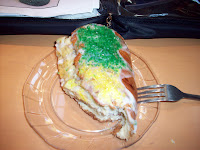I thought perhaps you would like to know how this started. Afterall, getting to know your dyer is a helpful way to get to know the products that you buy.
 |
| Trial and Error |
I started dyeing a few years ago when a friend of mine asked me to dye up some yarn in UW Husky colors (purple and gold) for a hat for a friend's son. I knew what was needed, and I knew that no one else would be providing that type of yarn commercially, so I did it. It took some trial and error, but it seemed like I was genuinely helping someone. That's when I started down the slippery slope of indie dyeing.
A few weeks after that, I picked up some yarn at my LYS and started tinkering in the kitchen. I dyed some colors that were really bad, before I figured out how to get the colors that I wanted. It was a lot of trial and error, but it was fun. It was a creative outlet. I had been burned pretty bad on a sweater project that I was doing (GAUGE ATTACK!), so knitting was in time-out.
A short time after that, I started looking at getting undyed yarn cheaply.
eBay and
KnitPicks were especially helpful. I read all the books I could on color theory and dyeing yarn. I think I spent more time researching those few weeks than I did actually dyeing anything.
Living in Seattle, we are particularly lucky to have greenery around us year round. But those grey skies can be a little depressing. I started dyeing jewel tones to cheer myself up. Reds and oranges, deep purples helped me remember that we do have a non-rainy season during the year.
Also, I am an art girl at heart. If I had any skill whatsoever with a paint brush, I would be doing oil paintings like Donatello or Botticelli.
 |
| Ceiling at St. Mary's |
Art is an act that gives me hope for humanity. Or maybe I could sculpt marble like the great Michelangelo! Unfortunately, I do not have the funding for something so huge. And I lack the patience as well. At least with dyeing yarn, it only takes about an hour start to finish in the kitchen for each colorway, and the supplies are commonly found.
I also find inspiration in clothing movements. Right now I am in love with the blend of metal and silky colors for SteamPunk. I like the layered effects that came back from the 80s (ahem, 80s hair...not so much. Trust me, I lived through the age of crimping. And it was horrific)
 |
| Homemade King Cake |
Sometimes even food can inspire me! Take this King Cake for example. Only a Mardi Gras favorite like King Cake could combine green, purple and gold and make it so festive with sprinkles! I took one look at that cake when my friend handed it to me, and said "I need to make that green!" It is things like this that inspire me. Food is often a colorful and cheerful affair, and I love to tinker around in the kitchen, so it is only natural that I find inspiration in the food that I eat.
The biggest inspiration so far is still my friends on Twitter and Plurk. I asked what you wanted to see, and you told me. You filled out my
Zoomerang survey, and told me what you wanted. I dye for you, my friends. You inspire me to try new things and see if they work.
What inspires your art? How do you keep going? Do you have anything to add?
I'll talk to you in the comments!

























